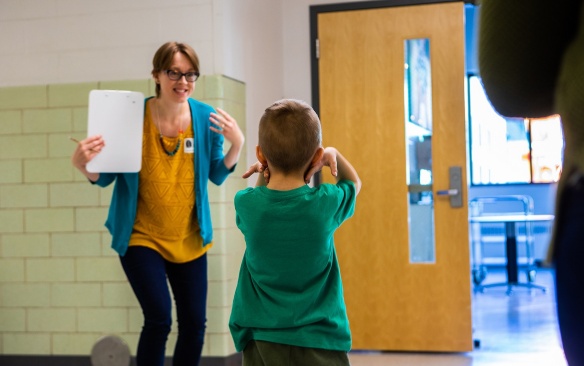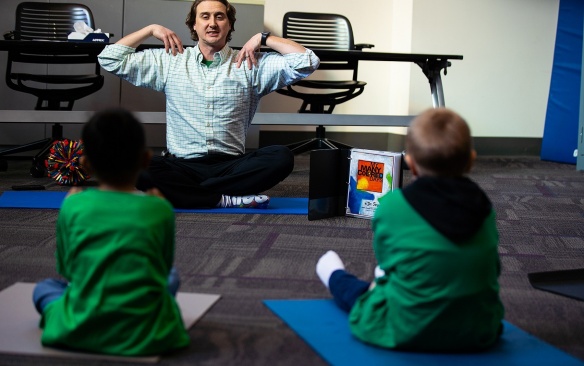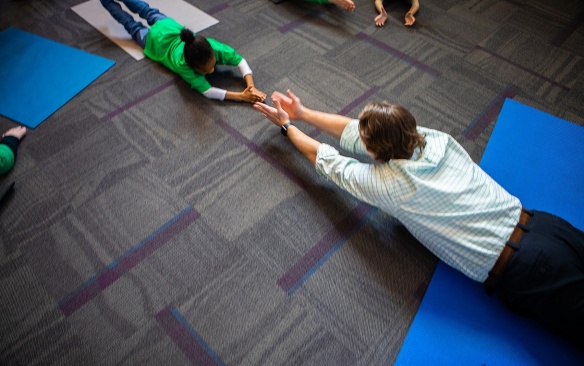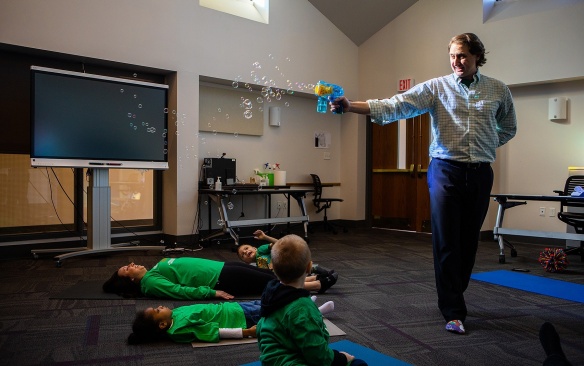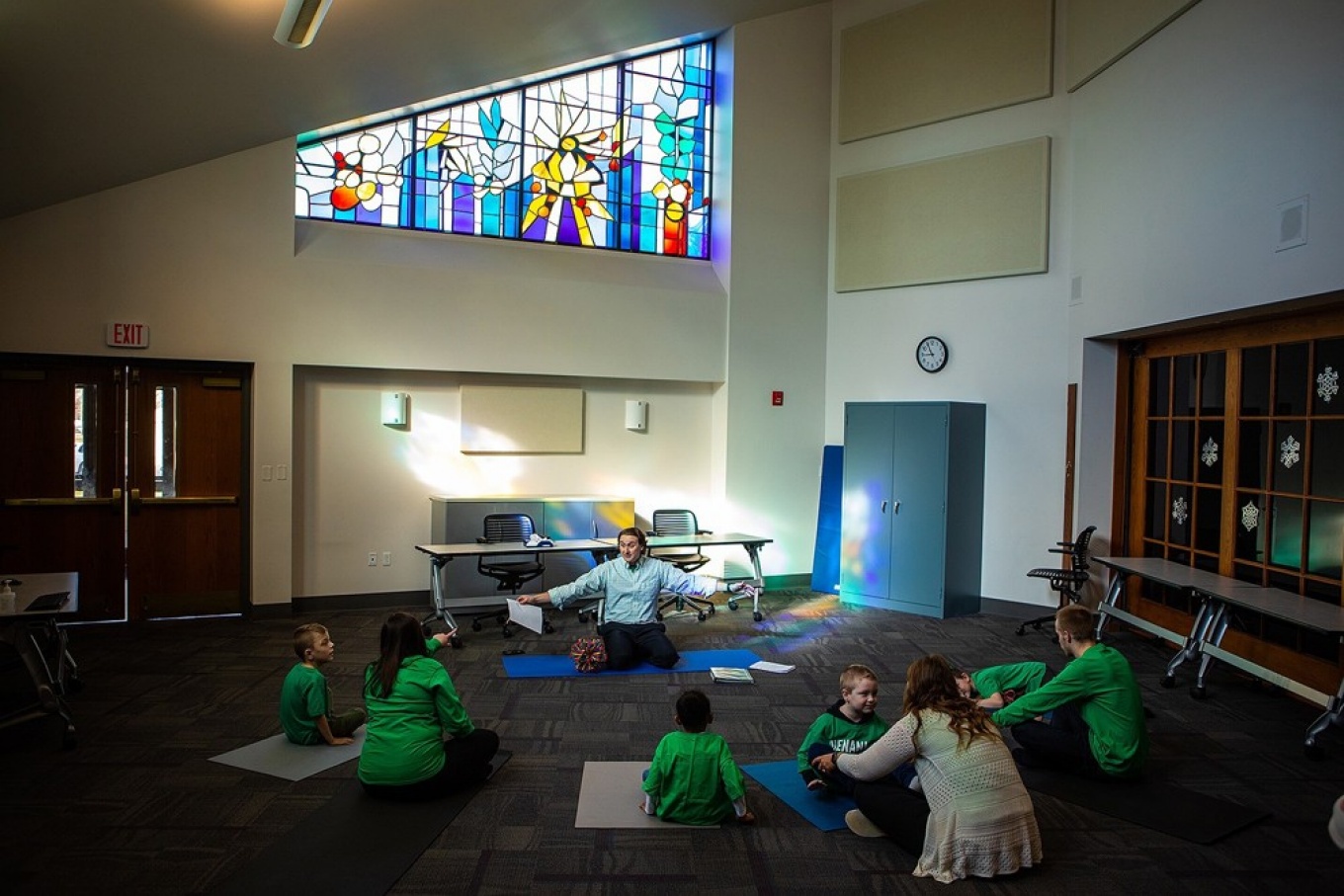
Vito Gigante, director of occupational therapy at the Beyond Learning Center (formerly the Cantalician Center for Learning), leads young children in a yoga practice. Photos: Douglas Levere
BY MARCENE ROBINSON
Published November 1, 2022
Unique partnership leads to new yoga program, assessment tool, music for children with disabilities
For 30 minutes a day, a dozen children meditated, read, sang and bounced around a room in the Beyond Learning Center in Depew. This was not your typical physical education course; this was a yoga class for children.
The students at the school were participating in the K-2 Let’s Move project, a study led by researchers in the Graduate School of Education to examine the effects of yoga on self-regulation and motor skills among K-2 children with developmental disabilities.
Yoga and mindfulness-based programs for children are known to build body awareness, decrease anxiety and assist stress management, said co-principal investigator Catherine Cook-Cottone, professor of counseling, school and educational psychology.
However, these effects are understudied in children with developmental disabilities, many of whom have difficulties with self-regulation—the ability to understand and manage behavior and reactions to feelings and sensory experiences. Self-regulation can impact a student’s ability to stay in their seat during class, follow their teacher’s directions, communicate, engage in fewer impulsive actions and not overreact to new situations.
“The concept of offering yoga to children with high needs is novel. These are society’s most marginalized individuals,” said Cook-Cottone. “As we work toward a more accepting and inclusive world, teaching a child how to self-regulate and mindfully engage in something gets them so much closer to being included. When negotiating peers and classrooms, there are so many rules about what you need to do to be included, and they often involve being self-regulated.”
New tools for self-regulation
To carry out the study, Cook-Cottone partnered with principal investigator Vito Gigante, director of occupational therapy at the Beyond Learning Center (formerly the Cantalician Center for Learning), and Claire Cameron, associate professor of learning and instruction, to develop a new curriculum and assessment tool. The project was also supported by Maria Priore, an alumna of the Graduate School of Education, who worked on the study as a graduate assistant and was funded by The Children's Guild.
Forty-eight students at the school were divided into two groups: half would receive a yoga and mindfulness-based curriculum three days per week, and the other half would continue to receive regularly occurring physical education classes. The groups were divided into cohorts of 12 and separated during classes and activities throughout the course of the study.
The effectiveness of the program was measured using a revised version of the Head-Toes-Knees-Shoulders (HTKS) assessment developed by Cameron to gauge the ability of young children to pay attention, remember rules and control impulses. The tool—designed as a short game—is used primarily by researchers to measure the skills necessary for success in school and aptitude for math and literacy skills.
The new assessment, Head-Toes for Exceptional Learners (HT-XL), is modified for children with high needs, with added direction to accommodate children who are non-verbal or who face barriers due to underdeveloped gross motor skills.
“Before this research, there were few ways beyond observation to study self-regulation in young children with disabilities. Typically, studies done in schools are expensive and resource-intensive, so most of the work happens through surveys,” said Cameron.
“How do the kids experience that learning process? How does it shift their ability to notice and be aware of themselves and make adjustments based on what they notice?” she said. “Now, we can actually measure this.”
The students were tested on their ability to self-regulate before and after taking part in the study to evaluate the effects of the curriculum. The researchers performed the HT-XL assessment, observed student behavior in the classroom and surveyed teachers by asking them to rate each student’s self-regulation skills.
The yoga and mindfulness-based curriculum—carried out over the course of 10 weeks—consisted of movement and breathing exercises, relaxation, meditation games, reading and music.
“We tell kids to pay attention, but nobody teaches them how. We tell them to calm down, but don’t tell them what that means,” said Gigante. “Yoga provides a period to move through routine and novelty, and offers many opportunities to self-regulate. The kids learn how to pay attention to the various sensory experiences, both externally and internally, as well as recognize how breathing can change how they feel inside and interpret feedback from the environment.”
Cook-Cottone added: “Most people think yoga is about calming down. It is that, but the goal is to also take children out of their comfort zone. We want them to learn how to manage challenges without falling apart.”
The researchers note they were forced out of their comfort zone by the COVID-19 pandemic and had to adapt by incorporating virtual instruction into the curriculum. They frequently used many of the practices they were teaching the students to de-stress, said Cameron.
One surprise development of the project was creation of the “Shoes on Song,” a tune to the melody of “Wheels on the Bus” to help the students transition from yoga or physical education to the classroom. Written by the research team and sung by Cook-Cottone’s daughter, Maya Cottone, the song helped the children overcome difficulties with putting on their shoes by forming a musical activity that describes the process. The idea for the song was conceived by Cameron, who found music helpful for her son who has Down syndrome and is the same age as the students in the study.
Profound results beyond the data
K-2 Let’s Move will soon bear several academic papers that detail the effectiveness of the yoga and mindfulness-based curriculum and HT-XL assessment for children with developmental disabilities.
The partnership between Cook-Cottone, Cameron and Gigante began over a shared interest in self-regulation and a personal passion for supporting children with high needs—Cook-Cottone’s brother also has Down syndrome, as do some of the students at the Beyond Learning Center, along with various other diagnoses.
The data collected over the course of nine months between October 2021 and June 2022 will both inform researchers who also share an interest in self-regulation and expand the tools available to educators who teach students with developmental disabilities.
Although the data is still being analyzed, the researchers have already observed a marked difference in the students.
Gigante recalls a student who at the start of the program ran around the studio during yoga, and by the end remained on their mat for an entire session. Cameron shares that a student who could not bend over without losing balance during the HT-XL assessment at the start of the study was able to finish the assessment by its completion.
“Everyone has it within them to self-regulate. We just need to provide them with the experiences,” Gigante said, adding that the skill will allow parents and teachers to rely less on external mechanisms, such as fidget spinners and weighted vests, to encourage self-regulation.
“When we only rely on the numbers, we miss the profound stories,” said Cameron. “We don’t know yet whether the data is statistically different, but it is evident that the yoga is doing something profound.”
The research is a sterling example of what can be accomplished when researchers, educators and families work together toward the same mission of helping children thrive. The culmination of efforts produced a unique study that many researchers would not have attempted, said Cook-Cottone.
“We are so grateful for the opportunity to bring the scientific, problem-solving method to the schools. The term for this is pragmatic research—the process of undertaking a real-world problem and using scientific methodologies to work toward a solution,” she said. “This wonderful community shared their challenges and ideas with us, and together we were able to study yoga in a way in which it has never been studied before.
“Perhaps, even more importantly, I think Vito and the kids had a lot of fun. I know we did.”
Tuesday News Briefs feature the stories of the Graduate School of Education faculty, students and alumni who are engaged in their communities and making an impact through their hard work, dedication and research initiatives. If you have a story to share, please email us with the details for consideration as a future news feature.


